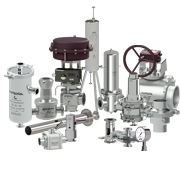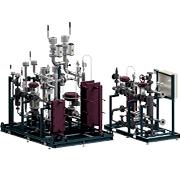- Steam traps
- Pressure regulators
- Control valves
-
- Control valves
- Two-way control valves
- Three-way control valves
- two-way on/off globe valves
- Intermittent blowdown valves & TDS blowdown control valves
- Pneumatic and electric linear actuators
- Universal controllers, transmitters, temperature sensors, digital panel, pneumatic and electric positioners
- Self-acting temperature control valves
- Two-way overflow valves
- Boiler house and special equipment
-
- Boiler house and special equipment
- Separators steam and compressed air
- Shell and tube & plate heat exchangers
- Sample coolers
- Direct steam injectors
- Flash vessels with inbuilt steam trap
- Blowdown expansion and cooling units in boiler houses
- Exhaust heads
- Hot condensate coolers
- Condensate lifting pots
- Steam-water mixers & Water-saving guns
- Level gauges & Magnetic level indicators
- Pressure operated pumps and packaged pump units
- Pipeline ancillaries
- Packaged units / Skids
- Clean steam equipment
-
- Clean steam equipment
- Clean Steam Generator
- Thermostatic clean steam traps
- Clean Service Control Valves
- Sanitary pressure regulators
- Clean Steam Separators
- Culinary steam filters
- Hygienic steam filters
- Clean Service Safety Valves
- Hygienic vacuum breakers
- Sample cooler clean steam
- Clean steam injectors
- Direct steam injection humidifiers
- Mushroom style air vent
- Three piece hygienic ball valves
- Three piece high purity ball valves
- Sanitary sight glass
- Sanitary pressure gauges
- Sanitary air vent valves
Steam traps

Pressure regulators

Control valves

Pipeline ancillaries

Clean steam equipment

Condensate is the result of the transition of a liquid from a vaporous state to a liquid state, due to the loss of heat by the steam. This physical phenomenon can have a negative impact on the equipment, causing water hammer, power loss and deterioration of the working substances. To prevent this, you need to install a steam trap.
What is a steam trap?
To prevent the formation of condensate in heat exchangers, special fittings are used - condensate traps. This category of equipment operates automatically and is designed to remove cooled steam from the walls of pipelines. These products are made from steel or ductile iron. The steam trap is fastened to other elements of the pipeline using a coupling or flange method.
Fields of application for this fitting include large and medium-sized industrial facilities, in the production processes of which water vapor is used, as well as in residential buildings where steam heating is used. The use of this fitting significantly increases the service life of the equipment and allows you to use heat more rationally.
Types of steam traps
There are several types of condensate drains.
The different structure and principle of operation of devices provides for their division into the following types:
Float valves, whose operation is based on the difference in densities of condensate and water vapor. With a high concentration of liquid, the float rises, opening a valve through which condensate is removed;
Thermodynamic, acting according to the laws of thermo- and aerodynamics. If there is condensate in the system, the fitting valve opens, releasing moisture. When steam starts to flow into the device, the valve closes;
Thermostatic, which work on the basis of the temperature difference between condensate and steam, as well as using the principle of expansion of bodies when heated, which opens the water outlet valve;
With a bimetal regulator, these are automatic steam traps that use a bimetal plate that changes shape when heated.







